Electrolux U 96040-4 i User Manual

SANTO
Built-In Refrigerator
Operating and Installation instructions
U 9 60 40-4 i
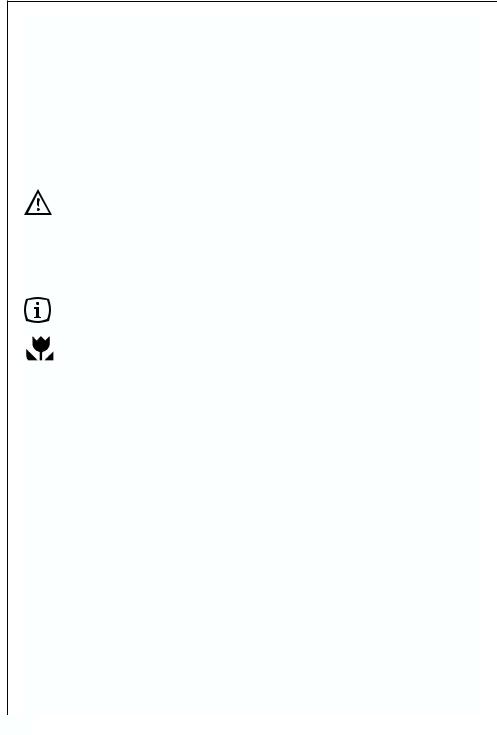
Dear customer,
Before switching on your new appliance please read these operating instructions carefully. They contain important information for safe use, for installation and for care of the appliance.
Please keep these operating instructions for future reference. Pass them on to possible new owners of the appliance.
These operating instructions are for use with several technically comparable models with varying accessories. Please observe the notes which apply to your model.
Notes which are important for your safety or for the proper functioning of the appliance are stressed with a warning triangle and/or with signal words (Warning!, Caution!, Important!). Please observe the fol-
lowing carefully.
1. This symbol guides you step by step in the operation of the appliance. 2. .....
Supplementary information regarding operation and practical applications of the appliance appear after this symbol.
Tips and notes concerning economical and environmentally sound use of the appliance are marked with the cloverleaf.
Explanations of the technical terminology used in the operating instructions can be found at the end in the section "Technical Terminology".
The operating instructions contain instructions for the correction of possible malfunctions by the user in the section "What to do if ...". If these instructions should not be sufficient, contact your local Service Force Centre.
Printed on paper manufactured with environmentally sound processes
he who thinks ecologically acts accordingly...
2

Contents
Important Safety Instructions . . . . . . . . . . . . . . . . . . . . . . . . . . . . . . . . . . . .4 Disposal . . . . . . . . . . . . . . . . . . . . . . . . . . . . . . . . . . . . . . . . . . . . . . . . . . . . . .6
Appliance Packaging Information . . . . . . . . . . . . . . . . . . . . . . . . . . . . . . . . . . .6 Disposal of old Appliances . . . . . . . . . . . . . . . . . . . . . . . . . . . . . . . . . . . . . . . . .6
Remove transport packaging . . . . . . . . . . . . . . . . . . . . . . . . . . . . . . . . . . . . .7 Installation . . . . . . . . . . . . . . . . . . . . . . . . . . . . . . . . . . . . . . . . . . . . . . . . . . .7
Installation Location . . . . . . . . . . . . . . . . . . . . . . . . . . . . . . . . . . . . . . . . . . . . .7 Grid preparation . . . . . . . . . . . . . . . . . . . . . . . . . . . . . . . . . . . . . . . . . . . . . . . . .8 Reversing the door . . . . . . . . . . . . . . . . . . . . . . . . . . . . . . . . . . . . . . . . . . . . . . .9 Changing over the freezer compartment door . . . . . . . . . . . . . . . . . . . . . . .10 Building the appliance in under a worktop . . . . . . . . . . . . . . . . . . . . . . . . . .11 Fitting the plinth . . . . . . . . . . . . . . . . . . . . . . . . . . . . . . . . . . . . . . . . . . . . . . . .16 Power supply . . . . . . . . . . . . . . . . . . . . . . . . . . . . . . . . . . . . . . . . . . . . . . . . . . .16 Electrical Connection . . . . . . . . . . . . . . . . . . . . . . . . . . . . . . . . . . . . . . . . . . . .17
Description of the appliance . . . . . . . . . . . . . . . . . . . . . . . . . . . . . . . . . . . .18
View of the appliance . . . . . . . . . . . . . . . . . . . . . . . . . . . . . . . . . . . . . . . . . . .18
Prior to Initial Start–Up . . . . . . . . . . . . . . . . . . . . . . . . . . . . . . . . . . . . . . .18 Starting up and temperature regulation . . . . . . . . . . . . . . . . . . . . . . . . . .19 Switching off the appliance . . . . . . . . . . . . . . . . . . . . . . . . . . . . . . . . . . . .20 Interior Accessories . . . . . . . . . . . . . . . . . . . . . . . . . . . . . . . . . . . . . . . . . . .20
Storage shelves . . . . . . . . . . . . . . . . . . . . . . . . . . . . . . . . . . . . . . . . . . . . . . . . .20 Variable storage box . . . . . . . . . . . . . . . . . . . . . . . . . . . . . . . . . . . . . . . . . . . .21 Bottle holder . . . . . . . . . . . . . . . . . . . . . . . . . . . . . . . . . . . . . . . . . . . . . . . . . .21
Correct storage . . . . . . . . . . . . . . . . . . . . . . . . . . . . . . . . . . . . . . . . . . . . . . .22 Freezing and storing frozen food . . . . . . . . . . . . . . . . . . . . . . . . . . . . . . . .22 Preparation of Ice Cubes . . . . . . . . . . . . . . . . . . . . . . . . . . . . . . . . . . . . . . .23 Defrosting . . . . . . . . . . . . . . . . . . . . . . . . . . . . . . . . . . . . . . . . . . . . . . . . . . .24 Cleaning and Care . . . . . . . . . . . . . . . . . . . . . . . . . . . . . . . . . . . . . . . . . . . .25 Energy Saving Tips . . . . . . . . . . . . . . . . . . . . . . . . . . . . . . . . . . . . . . . . . . . .26 What to do if ... . . . . . . . . . . . . . . . . . . . . . . . . . . . . . . . . . . . . . . . . . . . . . .27
Correcting Malfunctions . . . . . . . . . . . . . . . . . . . . . . . . . . . . . . . . . . . . . . . . .27 Changing the light bulb . . . . . . . . . . . . . . . . . . . . . . . . . . . . . . . . . . . . . . . . . .28
Regulations, Standards, Guidelines . . . . . . . . . . . . . . . . . . . . . . . . . . . . . . .28 Service and Spare Parts . . . . . . . . . . . . . . . . . . . . . . . . . . . . . . . . . . . . . . . .29 Customer Care Department . . . . . . . . . . . . . . . . . . . . . . . . . . . . . . . . . . . .29 Guarantee Conditions . . . . . . . . . . . . . . . . . . . . . . . . . . . . . . . . . . . . . . . . .30 Technical terminology . . . . . . . . . . . . . . . . . . . . . . . . . . . . . . . . . . . . . . . . .31 Noises during Operation . . . . . . . . . . . . . . . . . . . . . . . . . . . . . . . . . . . . . . .31
3

 Important Safety Instructions
Important Safety Instructions
These warnings are provided in the interests of your safety. Ensure you fully understand them before installing or using the appliance. Your safety is of paramount importance. If you are unsure about the meaning of these warnings contact the Customer Care Department for assistance.
Intended use
•The refrigerator is intended for use in the home. It is suitable for the cooling, freezing and storing of frozen food, as well as for making ice. If the appliance is used for purposes other than those intended or used incorrectly, no liability can be accepted by the manufacturer for any damage that may be caused.
•Alterations or changes to the refrigerator are not permitted for reasons of safety.
•If you use the refrigerator in a commercial application or for purposes other than the cooling, freezing or frozen storage of foods, the manufacturer accepts no liability for any damages which may occur.
Prior to initial start–up
•Check the appliance for transport damage. Under no circumstance should a damaged appliance be plugged in. In the event of damage, please contact your supplier.
•Ensure that the appliance does not stand on the electrical supply cable. Important: if the supply cable is damaged, it must be replaced by authorised service or qualified personnel using a special cable of the same type.
Refrigerant
The refrigerant isobutane (R600a) is contained within the refrigerant circuit of the appliance, a natural gas with a high level of environmental compatibility, which is nevertheless flammable.
•Warning - During transportation and installation of the appliance, be certain that none of the components of the refrigerant circuit become damaged.
•If the refrigerant circuit should become damaged:
–avoid open flames and sources of ignition;
–thoroughly ventilate the room in which the appliance is situated.
Safety of children
•Packaging (e.g. wraps, polystyrene) can be dangerous for children. There is a risk of suffocation! Keep packaging material away from children!
4

Important Safety Instructions
•Please make old appliances unusable prior to disposal. Pull out the mains plug, cut off the mains cable, break or remove spring or bolt catches, if fitted. By doing this you ensure that children cannot lock themselves in the appliance when playing (there is risk of suffocation!) or get themselves into other dangerous situations.
•Often children cannot recognise the hazards present in household appliances. It is therefore important that you ensure adequate supervision and never let children play with the appliance!
Daily Operation
•Containers with flammable gases or liquids can leak at low temperatures. There is a risk of an explosion! Do not store any containers with flammable materials such as spray cans, fire extinguisher refill cartridges etc in the refrigerator/freezer.
•Bottles and cans must not be placed in the freezer compartment. They can burst when the contents freeze, high carbonate content drinks can even explode! Never store lemonade, juices, beer, wine, sparkling wine etc. in the freezer compartment.
•Do not place ice cream or ice cubes in the mouth immediately after removal from the freezer compartment. Very cold ice can freeze to the lips or tongue and cause injury.
•Do not touch frozen food with wet hands. Your hands could freeze to the food.
•Warning - Do not operate any electrical appliances in the refrigerator and/or freezer (e.g. electric ice cream makers, mixers etc.).
•Warning - In order not to impair the function of the appliance, never cover or obstruct the ventilation openings.
•Warning - Do not damage the cooling circuit.
•Warning - Do not use any mechanical devices or other artificial means to speed up defrosting unless they are recommended by the manufacturer.
•Before cleaning the appliance, always switch off the appliance and unplug it, or disconnect from the electricity supply.
•When unplugging always pull the plug from the mains socket, do not pull on the cable.
In case of malfunction
•If a malfunction occurs on the appliance, please look first in the "What to do if ..." section of these instructions. If the information given there does not help, please do not perform any further repairs yourself.
•This product should be serviced by an authorised engineer and only genuine spare parts should be used.
5
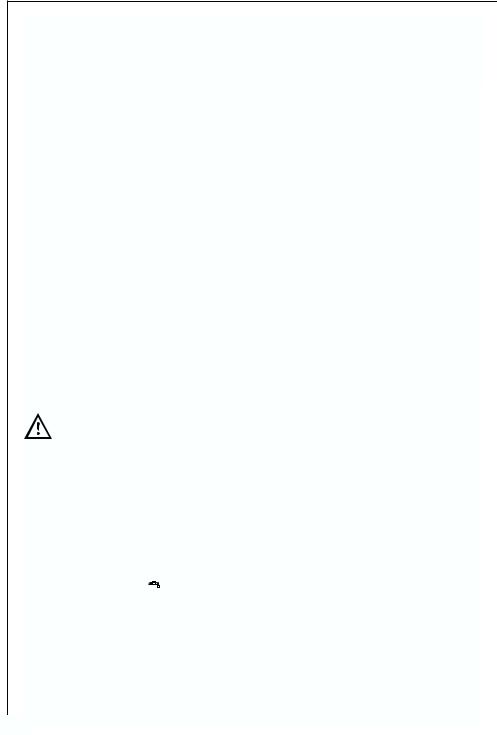
•Under no circumstances should you attempt to repair the appliance yourself. Repairs carried out by inexperienced persons may cause injury or serious malfunctioning. Contact your local AEG Service Force Centre.
Disposal
Appliance Packaging Information
All materials are environmentally sound! They can be disposed of or burned at an incinerating plant without danger.
About the materials: The plastics can be recycled and are identified as follows:
>PE< for polyethylene, e.g. the outer covering and the bags in the interior.
>PS< for polystyrene foam, e.g. the pads, which are all free of chlorofluorocarbon.
The carton parts are made from recycled paper and should be disposed of at a waste-paper recycling collection location.
Disposal of Old Appliances
For environmental reasons, refrigeration appliances must be disposed of properly. This applies to your old appliance, and - at the end of its service life - for your new appliance as well.
Warning! Before disposing of old appliances make them inoperable. Remove plug from mains, sever the power cable, remove or destroy any snap or latch closures. This ensures that children do not lock themselves inside the appliance (danger of suffocation!) or place themselves into other life-endangering situations.
Disposal:
•The appliance may not be disposed of with domestic waste or bulky refuse.
•The refrigerant circuit, especially the heat exchanger at the back of the appliance, must not be damaged.
•The symbol  on the product or on its packaging indicates that this product may not be treated as household waste. Instead it shall be handed over to the applicable collection point for the recycling of electrical and electronic equipment. By ensuring this product is disposed of correctly, you will help prevent potential negative consequences for the environment and human health, which could otherwise be caused by inappropriate waste handling of this product. For more detailed information about recycling of this product, please
on the product or on its packaging indicates that this product may not be treated as household waste. Instead it shall be handed over to the applicable collection point for the recycling of electrical and electronic equipment. By ensuring this product is disposed of correctly, you will help prevent potential negative consequences for the environment and human health, which could otherwise be caused by inappropriate waste handling of this product. For more detailed information about recycling of this product, please
6

contact your local city office, your household waste disposal service or the shop where you purchased the product.
Remove transport packaging
The appliance and the interior fittings are protected for transport.1. Pull off the adhesive tape on the left and right side of the door.
2.Remove all adhesive tape and packing pieces from the interior of the appliance.
Installation
Installation Location
The appliance should be set up in a well ventilated, dry room.
Energy use is affected by the ambient temperature. The appliance should therefore
–not be exposed to direct sunlight;
–not be installed next to radiators, cookers or other sources of heat;
–only be installed at a location whose ambient temperature corresponds to the climate classification, for which the appliance is designed.
The climate classification can be found on the rating plate, which is located at the right on the inside of the appliance.
The following table shows which ambient temperature is correct for each climate classification:
Climate classification |
|
for an ambient temperature of |
|
|
|
|
|
|
SN |
|
+10 to +32 °C |
|
|
|
|
|
|
N |
|
+16 to +32 °C |
|
|
|
|
|
|
ST |
|
+18 to +38 °C |
|
|
|
|
|
|
T |
|
+18 to +43 °C |
|
|
|
Installation directly under a hob is not allowed. The temperatures of the hob, which in part are quite high, may damage the appliance.
If a hob is installed near the appliance, the corresponding installation and safety instructions must be adhered to. Considering the numerous installation conditions which are possible, there is no way of providing detailed information here.
7
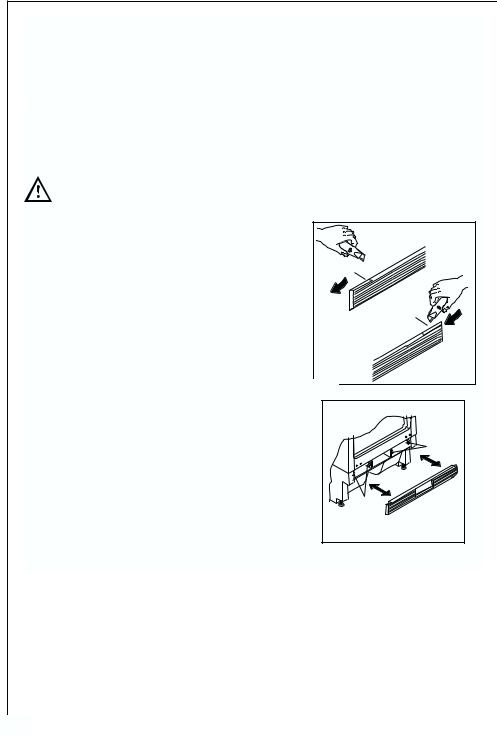
Installation
It is necessary to avoid overheating of the refrigerator by maintaining adequate distances from heat sources and by the use of a suitable thermal insulation plate. Proper ventilation of the appliance must also be ensured.
Grid preparation
The side at which the door opens can be changed from the right side (as supplied) to the left side, if the installation site requires.
Warning! When changing the side at which the door opens, remove plug from the mains.
Left door opening:
1. Remove the left side (A) of the grid cutting it from the rear (see figure).
2.Remove the right side (B) of the grid cutting it from the rear (see figure).
A |
B |
DO002/2 |
3.Re-install the grid to the base of the appliance by pushing on to the clasps (a) until they click.
a |
a |
DO001 |
8
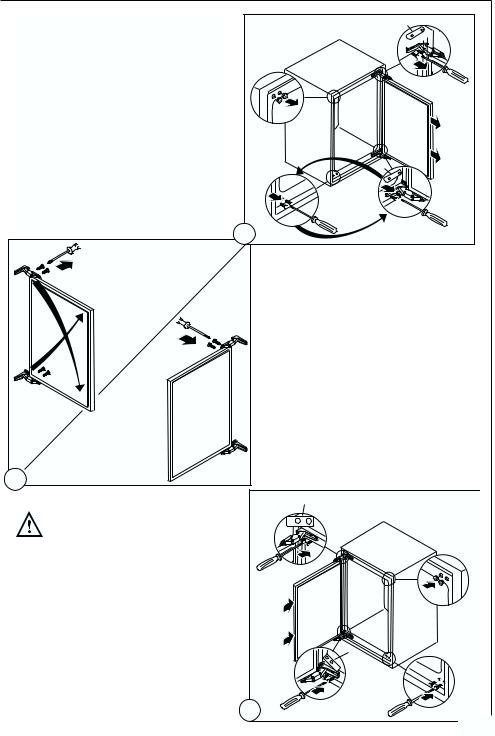
Installation
Reversing the door
The side at which the door opens can be changed from the right side (as supplied) to the left side, if the installation site requires.
To reverse the opening direction of the door, proceed as shown in the figures:
1
6
2
1
2
6
4 

5
6
3
Warning! After completion of the door reversing operation, check that the door gasket adheres to the cabinet. If the ambient temperature is cold (i.e. in Winter), the gasket may not fit perfectly to the cabinet. In that case, wait for the natural fitting of the gasket or accelerate this process by heating up the part involved with a normal hairdryer on a low setting.
6 |
|
10 |
|
|
13 |
9 |
|
6 |
12 |
11 |
|
3 |
9 |
|
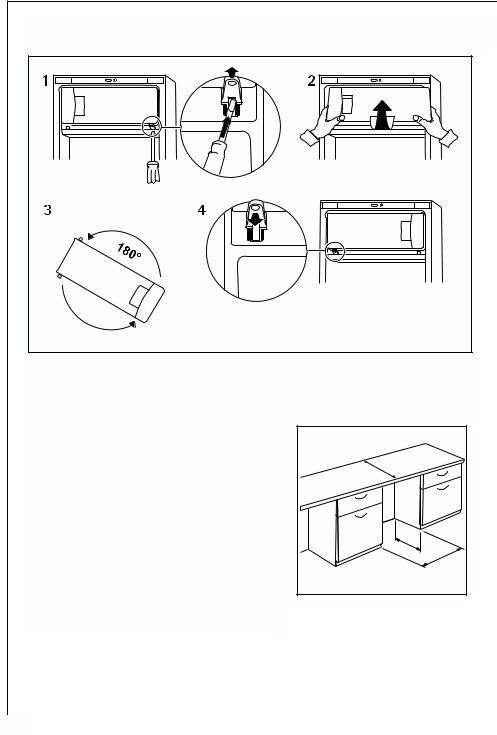
Installation
Changing over the freezer compartment door
Building the appliance in under a worktop
The dimensions of the recessed installation area must correspond with those indicated in the figure.
600 |
550 |
min. |
600 |
DO013 |
10
